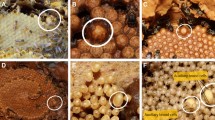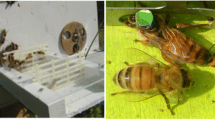Abstract
Queen, worker, and male production was studied for 1 year in three queenright colonies of Tetragonisca angustula (Latreille). We sampled brood combs monthly and noticed that the number of brood cells and production of individuals were similar among colonies. Although the production of queens did not vary significantly, the frequencies of workers, males, and the number of cells among the combs varied over time. The production of males was highly seasonal, occurring mostly from February to April, coinciding with the period of intense brood cells production, when colonies produced more males and less workers, resulting in a negative correlation. Although the frequency of queens has not varied in time, the seasonal availability of males affected the mating frequency and the time spent since emergence until fertilization of queens. In the T. angustula colonies studied, the population dynamics was highly seasonal and the mating success depended of male production, according to the season.




Similar content being viewed by others
References
Aidar DS (1999) Coleta de ninhos de Jataí (Tetragonisca angustula). Paracatu, Fundação Acangau, 32 p
Alves DA, Imperatriz-Fonseca VL, Santos-Filho PS (2009) Production of workers, queens and males in Plebeia remota colonies (Hymenoptera, Apidae, Meliponini), a stingless bee with reproductive diapause. Genet Mol Res 8(2):672–683
Bego LR (1982) On social regulation in Nannotrigona (Scaptotrigona) postica Latreille, with special reference to male production cycles (Hymenoptera, Apidae, Meliponinae). Bol Zool Univ Sao Paulo 7:181–196
Bego LR (1990) On social regulation in Nannotrigona postica Latreille, with special reference to productivity of colonies (Hymenoptera, Apidae, Meliponinae). Rev Bras Entomol 34:721–738
Beig D (1972) The production of males in queenright colonies of Trigona (Scaptotrigona) postica. J Apic Res 11:33–39
Bourke AFG, Ratnieks FLW (1999) Kin conflict over caste determination in social Hymenoptera. Behav Ecol Sociobiol 46:287–297
Cabral GCP, Imperatriz-Fonseca VL (2007) Produção de machos, rainhas e operárias em Colônias de Nannotrigona testaceicornis Lepeletier Durante a Primavera e Verão (Apidae, Meliponinae). In: Anais do VIII Congresso de Ecologia do Brasil, Caxambu, 1–2
Camargo CA (1972) Determinação de castas em Scaptotrigona postica Latreille (Hymenoptera, Apidae). Rev Bras Biol 32:133–138
Camargo JMF, Pedro SRM (1992) Systematics, phylogeny and biogeographic of the meliponinae (Hymenoptera, Apidae): a mini-review. Apidologie 23:509–522
Camargo JMF, Pedro SRM (2007) Meliponini Lepeletier, 1836. In: Moure JMS, Urban D, Melo GAR (eds) Catalogue of bees (Hymenoptera, Apoidea) in the Neotropical Region. Sociedade Brasileira de Entomologia, Curitiba, pp 273–578
Chinh TX, Sommeijer MJ (2005) Production of sexuals in the stingless bee Trigona (Lepidotrigona) ventralis flavibasis Cockerell (Apidae, Meliponini) in northern Vietnam. Apidologie 36:493–503
Cortopassi-Laurino M, Gelli DS (1991) Analyse pollinique, proprietés physico-chimique et action antibactérienne des miels d'abeilles africanisées Apis mellifera et des Méliponines du Brésil. Apidologie 22:61–73
Darchen R, Delage-Darchen B (1971) Le déterminisme des castes chez les Trigones (Hyménoptères Apidés). Insect Soc 18:121–134
Engels W, Imperatriz-Fonseca VL (1990) Caste development, reproductive strategies, and control of fertility in honey bees and stingless bees. In: Engels W (ed) Social Insects: An evolutionary approach to castes and reproduction. Springer, Berlin, pp 167–230
Faustino CD, Silva-Matos EV, Mateus S, Zucchi R (2002) First record of emergency queen rearing in stingless bees (Hymenoptera, Apinae, Meliponini). Insect Soc 49:111–113
Grosso AF, Bego LR, Martinez AS (2000) The production of males in queenright colonies of Tetragonisca angustula angustula (Hymenoptera, Meliponinae). Sociobiology 35:475–485
Hartfelder K, Engels W (1989) The composition of larval food in stingless bees: evaluating nutritional balance by chemosystematic methods. Insect Soc 36(1):1–14
Hartfelder K, Makert GR, Judice CC, Pereira GAG, Santana WC, Dallacqua R, Bitondi MMG (2006) Physiological and genetic mechanisms underlying caste development, reproduction and division of labor in stingless bees. Apidologie 37:144–163
Imperatriz-Fonseca VL, Kleinert-Giovannini A, Cortopassi-Laurino M, Ramalho M (1984) Hábitos de coleta de Tetragonisca angustula angustula Latreille (Hymenoptera, Apidae, Meliponinae). Bol Zool Univ Sao Paulo 8:115–131
Kerr WE (1948) Estudos sobre o gênero Melipona. An Escola Super Agric “Luiz de Queiroz” 5(2):181–276
Kerr WE (1950) Genetic determination of castes in the genus Melipona. Genetics 35:143–152
Kerr WE (1969) Some aspects of the evolution of social bees (Apidae). Evol Biol 3:119–175
Kerr WE, Nielsen RA (1966) Evidence that genetically determined Melipona queens can become workers. Genetics 54:859–865
Kerr WE, Stort AC, Montenegro MJ (1966) Importância de alguns fatores ambientais na determinação das castas do gênero Melipona. An Acad Bras Cienc 38:149–168
Koedam D, Velthausz PH, van der Krift T, Dohmen MR (1996) Morphology of reproductive and trophic eggs and their controlled release by workers in Trigona (Tetragonisca) angustula Illiger (Apidae, Meliponinae). Physiol Entomol 21:289–296
Koedam D, Contrera FAL, Imperatriz-Fonseca VL (1999) Clustered male production by workers in the stingless bee Melipona subnitida Ducke (Apidae, Meliponinae). Insect Soc 46:387–391
Lacerda LM, Zucchi R (1999) Behavioral alterations and related aspects in queenless colonies of Geotrigona mombuca (Hymenoptera, Apidae, Meliponinae). Sociobiology 33:277–288
Lacerda LM, Simões ZLP, Velthuis HHW (2010) The sharing of male production among workers and queens in Scaptotrigona depilis (Moure, 1942) (Apidae, Meliponini). Insect Soc 57:185–192
Michener CD (2000) The bees of the world. The Johns Hopkins University Press, Baltimore
Moo-Valle H, Quezada-Euán JJG, Wenselleers T (2001) The effect of food reserves on the production of sexual offspring in the stingless bee Melipona beecheii (Apidae, Meliponini). Insect Soc 48:398–403
Nogueira-Neto P (1997) Vida e Criação de Abelhas Indígenas sem Ferrão. São Paulo, Nogueirapis Editora, 445 p
Oliveira RC, Nunes FMF, Campos APS, Vasconcelos SM, Roubik D, Goulart LR, Kerr WE (2004) Genetic divergence in Tetragonisca angustula Latreille, 1811 (Hymenoptera, Meliponinae, Trigonini) based on RAPD markers. Genet Mol Biol 27(2):181–186
Paxton RJ, Bego LR, Shah MM, Mateus S (2003) Low mating frequency of queens in the stingless bee Scaptotrigona postica and worker maternity of males. Behav Ecol Sociobiol 53:174–181
Ratnieks FLW (2001) Heirs and spares: caste conflict and excess queen production in Melipona bees. Behav Ecol Sociobiol 50:467–473
Reuter M, Keller L (2001) Sex ratio conflict and worker production in eusocial Hymenoptera. Am Nat 158:166–177
Ribeiro MF, Wenseleers T, Santos-Filho OS, Alves DA (2006) Miniature queens in stingless bees: basic facts and evolutionary hypotheses. Apidologie 37:191–206
Roubik DW (1983) Nest and colony characteristics of stingless bees from Panama (Hymenoptera: Apidae). J Kansas Entomol Soc 56:327–355
Roubik DW (1989) Ecology and natural history of tropical bees. Cambridge University Press, Cambridge, 194 p
Sakagami SF (1982) Stingless bees. In: Hermann HR (ed) Social insects. Academic, New York, 423 p
Sakagami SF, Beig D, Zucchi R, Akahira Y (1963) Occurrence of ovary-developed workers in queenright colonies of stingless bees. Rev Bras Biol 23:115–129
Santos-Filho PS, Alves DA, Eterovic A, Imperatriz-Fonseca VL, Kleinert AMP (2006) Numerical investment in sex and caste by stingless bees (Apidae: Meliponini): a comparative analysis. Apidologie 37:207–221
Silveira FA, Melo GAR, Almeida EAB (2002) Abelhas Brasileiras: Sistemática e Identificação, Belo Horizonte, 253 p
Sommeijer MJ, Bruijn LLM, Meeussen FJAF, Martens EP (2003) Natural patterns of caste and sex allocation in the stingless bees Melipona favosa and M. trinitatis related to workers behavior. Insect Soc 50:38–44
Terada Y (1974) Contribuição ao estudo da regulação social em Leurotrigona muelleri e Frieseomelitta varia (Hymenoptera, Apidae), Msc thesis, Universidade de São Paulo
Tóth E, Strassmann JE, Nogueira-Neto P, Imperatriz-Fonseca VL, Queller DC (2002) Male production in stingless bees: variable outcomes of queen-worker conflict. Mol Ecol 11:2661–2667
Tóth E, Queller DC, Dollin A, Strassmann JE (2004) Conflict over male parentage in stingless bees. Insect Soc 51:1–11
van Benthem FDJ, Imperatriz-Fonseca VL, Velthuis HHW (1995) Biology of the stingless bee Plebeia remota (Holmberg): observations and evolutionary implications. Insect Soc 42:71–87
van Veen JW, Sommeijer MJ (2000a) Colony reproduction in Tetragonisca angustula (Apidae, Meliponini). Insect Soc 47:70–75
van Veen JW, Sommeijer MJ (2000b) Observations on gynes and drones around nuptial flights in the stingless bees Tetragonisca angustula and Melipona beecheii (Melipona). Apidologie 31:47–54
van Veen JM, Sommeijer MJ, Arce HG (1999) The role of colony development and resource availability in the regulation of queen production in Melipona beecheii (Apidae, Meliponini). In: van Veen JW (ed) Colony reproduction in stingless bees. Utrecht Univ, Litografia Imprenta Lil SA, San Jose, pp 80–87
Velthuis HHW, Sommeijer MJ (1991) Roles of morphogenetic hormones in caste polymorphism in stingless bees. In: Gupta AP (ed) Morphogenetic hormones of arthropods. Rutgers University Press, New Jersey, pp 346–383
Velthuis HHW, Koedam D, Imperatriz-Fonseca VL (2005) The males of Melipona and other stingless bees, and their mothers. Apidologie 36:169–185
Wenseleers T, Ratnieks FL, Billen J (2003) Caste fate conflict in swarm-founding social hymenoptera: an inclusive fitness analysis. J Evol Biol 16:647–658
Wheeler DE (1986) Developmental and physiological determinants of caste in social Hymenoptera: evolutionary implications. Am Nat 128:13–34
Wilde J, Beetsma J (1982) The physiology of caste development in social insects. Adv Insect Physiol 16:167–245
Acknowledgments
This research was supported by Fapesp (Fundação de Amparo à Pesquisa do Estado de São Paulo; no. 08/52339-3) and was included in the Biota thematic project “Biodiversity and sustainable use of pollinators with emphasis in Meliponini bees”, also funded by Fapesp (no. 04/15801-0). We are grateful to two anonymous referees and the editor in chief for their valuable comments on the manuscript.
Author information
Authors and Affiliations
Corresponding author
Additional information
Edited by Fernando B Noll – UNESP
Rights and permissions
About this article
Cite this article
Prato, M., Soares, A.E.E. Production of Sexuals and Mating Frequency in the Stingless Bee Tetragonisca angustula (Latreille) (Hymenoptera, Apidae). Neotrop Entomol 42, 474–482 (2013). https://doi.org/10.1007/s13744-013-0154-0
Received:
Accepted:
Published:
Issue Date:
DOI: https://doi.org/10.1007/s13744-013-0154-0




